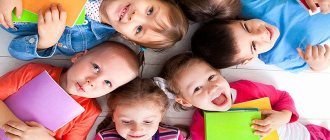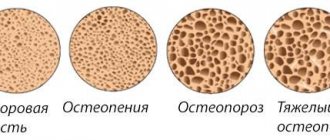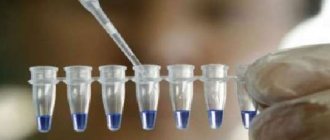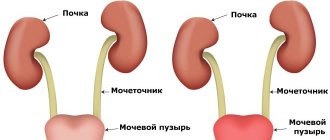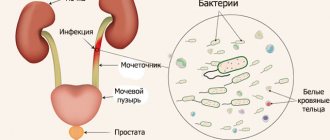BLD in a urine test is most often not a good thing. This parameter in the test results may indicate the presence of an inflammatory process in the genitourinary area or in the kidneys. Naturally, if the parameter value exceeds the norm.
A person very often takes tests to diagnose the body, but has no idea what the medical terms on the test form say. What is BLD in urinalysis? What can red blood cells tell you about in urine, what danger do they pose to humans? Pathology or physiology? We will learn all this later in the article.
Bld in urine - what does it mean?
Red blood cells in the urine, defined as more than three in the field of view, are called in medicine the term “ hematuria ,” which in turn is classified into:
- Microhematuria is a phenomenon in which the color of the urine is normal (from light yellow to yellow), but red blood cells are detected as a result of microscopy of the sediment.
- Macrohematuria - the color of urine can be brown, red, or brown.
- Renal (renal) - the causes of hematuria are renal diseases: trauma, tuberculosis or heart attack, acute glomerulonephritis.
- Extrarenal (extrarenal) – occurs with urogenital diseases: cystitis, prostatitis, urethritis.
When conducting three-glass tests, hematuria is also divided into initial, final or terminal - depending on which portion of urine contains blood.
If red blood cells are detected in the urine, a repeat general clinical test is always prescribed. If the second time the result is positive, then the diagnosis of pathologies of the kidneys and urinary tract is beyond doubt.
Hematuria is one of the most common symptoms of diseases and injuries of the urinary system. The most dangerous type of hematuria is macrohematuria , which mainly appears with cancer of the kidneys, pelvis, bladder and ureter, and can also accompany urolithiasis and tuberculosis.
Decoding the bld indicator
Bld is the number of red blood cells contained in the urine. The normal value depends on the gender of the patient. For women, their number should not exceed 3 cells in the field of view, for men - no more than two.
If BLD is elevated, this indicates hematuria (the presence of red blood cells in the urine). Causes of the condition:
- mechanical damage to the wall of the mucous membrane of the urinary system (after medical procedures, in the presence of stones);
- infections;
- inflammatory diseases (cystitis);
- poisoning;
- hemorrhagic diathesis;
- hypertonic disease;
- kidney diseases (pyelonephritis, glomerulonephritis).
In women, hematuria may be detected after the end of menstruation. The result is considered a false positive.
Hematuria in a child
The causes of hematuria in children can be classified according to the frequency of their manifestation depending on the age of the child:
- Hematuria in infants often occurs with thrombosis of the renal vein due to acute infections, with malformations of the genitourinary system, and hemorrhagic disease of the newborn.
- In preschool children, the appearance of blood in the urine is often caused by injuries and damage to the external genitalia, urinary tract infection, glomerulonephritis, kidney tumor or abnormalities of their development.
- In school-age children, red blood cells in the urine can be detected in cases of kidney injuries and tumors, inflammation of the urinary tract (cystitis, urethritis), glomerulonephritis, pyelonephritis, thrombopathy, systemic lupus erythematosus.
You need to know that it is impossible to diagnose the disease based on hematuria alone. Additionally, a wide range of studies are carried out: ultrasound of the kidneys and urinary tract, microscopy analysis of urine sediment, three-glass samples, blood biochemistry and related diagnostic techniques to determine possible pathologies.
Symptom in men
Hematuria in men is often a sign of inflammatory urogenital diseases (urethritis, prostatitis). Microhematuria (insignificant) the number of red blood cells in the urine can be determined in chronic prostatitis. Macrohematuria is observed in pathological conditions of the urethra (urethritis, malignant tumors, papillomas, genital warts) as well as in inflammation of the bladder, acute prostatitis.
, three-glass samples are used in urology . If blood is diagnosed in the first glass of urine, then this indicates damage to the urethra, in the third glass - diseases of the prostate gland and bladder. If blood is detected in all portions (total hematuria), this is a sign of kidney and bladder disorders.
Among women
Red blood cells in the urine of women can be detected in cases of gynecological diseases, pathologies of the kidneys and urinary tract.
Blood in the urine of women can be detected during menstruation and in various inflammatory and infectious gynecological diseases (erosion, vulvitis, urogenital chlamydia), therefore, to diagnose kidney disorders, it is important to take a urine test during the absence of menstruation and after thorough treatment of the perineum. To prevent vaginal discharge from getting into the urine container, close the vagina with a cotton swab before urinating. In some cases, in hospital settings, a woman’s urine is collected with a catheter.
Hematuria is a symptom of the following diseases:
- Pyelonephritis and glomerulonephritis in the acute phase;
- Urethritis, cystitis, prostatitis;
- Malignant formations of the urinary system;
- Heart attack and kidney tuberculosis;
- Injury to the organs of the urinary system;
- Urolithiasis disease;
- Nephrotic syndrome.
Hematuria during pregnancy
A common occurrence during pregnancy, especially in its last stages, is pregnancy nephropathy , which is caused by increased load on the kidneys and is characterized by the appearance of protein in the urine, edema and increased blood pressure. With nephropathy in pregnant women, red blood cells in the urine can be detected in small quantities, no more than 10.
Also, in pregnant women with a history of chronic pyelonephritis , its transition to the acute stage is possible, which is also diagnosed by the appearance of red blood cells (no more than 10), leukocytes and bacteria in the urine.
Blood in the urine during pregnancy can be observed with pregnant hemorrhoids , especially with internal nodes, which in the early stages do not have any other clinical symptoms other than heavy bleeding.
Their appearance
Depending on their specific gravity, as well as on the reaction of the biomaterial, red blood cells can change their appearance. Thus, they occur in the form of fresh, unaltered and leached, altered components. Unmodified red blood cells contain hemoglobin and are shaped like yellow-green discs.
Such components do not contain hemoglobin, and their shape looks like a colorless ring. Such red blood cells are called leached. In addition, altered elements include wrinkled red blood cells, which can be found in urine that has an increased specific gravity. It is worth noting that in urine, which has a low relative density, the diameter of red blood cells increases noticeably.
During long standing, red blood cells acquire a changed shape. This separation has no significance for determining hematuria, since in many situations the change in these components is influenced by the physical and, in addition, the chemical properties of the biomaterial. What BLD means in a urine test is of interest to many.
Renal signs of hematuria are most often indicated by leached red blood cells, which can be found in fresh urine. The main sign for establishing the renal origin of blood cells is the appearance of protein in the urine. As a rule, the ingress of red blood cells indicates kidney diseases and ailments of the urinary tract.
Red blood cell norm
Normally, the color of urine should be from light yellow to yellow, and red blood cells in its sediment should not be detected. However, it should be remembered that its color may change under the influence of various dyes; for example, after eating beets, its tint may be pinkish. On general clinical test forms, blood in the urine is indicated by the abbreviations “KRO” or “BLD.” Normally, opposite these designations there is a “NEG” symbol, which means a negative result.
The determination of red blood cells in quantities exceeding the norm is recorded with the symbols “+”, “++”, “+++”, which means their number or numerical values.
What does the quantity 10 rbc/ul mean?
The determination of erythrocytes in urine in the amount of 10 cells per field of view can be observed in chronic renal failure, nephrotic syndrome, and pyelonephritis. Also, a small amount of them can be detected during inflammation of the reproductive system in women (endometritis, cervical erosion, vulvitis). You can also differentiate kidney disease from inflammatory diseases of the genital organs through a general clinical urine test, paying attention to the following criteria.
In chronic renal failure, leukocytes are also found in small quantities. The main sign indicating chronic renal failure is a decrease in urine density (“SG” on the form) to 1.010. Traces of mucus and single cylinders are also found.
Nephrotic syndrome is indicated by a protein content of up to 40 g/l, up to 20 leukocytes and a large number of cylinders.
Pyelonephritis is characterized by a large number of leukocytes up to 100, a low protein content - up to 2 g/l, and the presence of casts, bacteria and mucus.
This number of red blood cells in the urine test form is also indicated by the “+” symbol.
Relative density of urine
The relative density or specific gravity of urine is denoted by two Latin letters s g. This parameter has diagnostic value only when determining density over a certain time interval, most often 24 hours. The norm for urine density is 1.028, and for children – up to 1.026.
Hypersthenuria is combined with proteinuria and indicates a serious pathology in the urinary system. A decrease in specific gravity below 1.025 is called hyposthenuria, and the concentration of most chemical elements in the urine is reduced. Hyposthenuria is often combined with polyuria, i.e. increased urine output.
What does the 250 rbc/ul indicator mean?
Red blood cells in the urine in the amount of 250 indicate macrohematuria , that is, we can say that a person’s bladder is emptied with blood, so high is its content. Urine is red or brown in color . This condition is dangerous to human health. Gross hematuria often indicates malignant kidney tumors. It can also be observed with renal infarction and urolithiasis after attacks, with acute glomerulonephritis.
The patient must be subject to additional examination: microscopy of urine sediment, culture test, three-glass or two-glass samples, ultrasound and MRI of the kidneys and bladder, blood biochemistry, kidney biopsy.
9 minutes Author: Lyubov Dobretsova 3066
Clinical tests of urine and blood are informative and the most accessible methods of laboratory diagnostics. All studied elements have certain norms of content and letter article. The Latin abbreviation Bld in urine analysis indicates the presence and number of blood cells with a characteristic red color - erythrocytes.
Erythrocytes belong to the formed bodies of the cellular part of the blood. In correlation with the protein hemoglobin, they perform several important functions:
- maintaining the stability of the acid-base state (ABS) of the blood;
- delivery of oxygen from the lungs to organ tissues, and movement of carbon dioxide molecules in the opposite direction;
- transportation of foreign agents (antigens) that have entered the blood into liver cells for their further elimination;
- absorption of certain drugs and amino acids, and their transfer from the gastrointestinal tract (gastrointestinal tract) to body tissues.
The presence of Bld in urine is allowed in minute quantities (in the field of view). In other body fluids (sweat, semen, phlegm, etc.), the presence of blood cells is abnormal.
Urine analysis for organic substances
Protein scores are designated Pro. They should not exceed 0.03. In diabetics, MAU readings should be within the range of 4.25 mmol. From this result you can learn about the reversibility of kidney damage. Its level is monitored to monitor pathologies in order to begin treatment in a timely manner.
The glucose level is designated Glu. The best result is no sugar. If it is present, then we can talk about the presence of diabetes mellitus.
Bilirubin is designated as Bil. The ideal is its absence. If bilirubin is present, gallbladder or liver problems may occur. The explanation of BLD in urine analysis is presented below.
Urobilinogen (aka URO) is designated UBG and should be present in urine. This indicator is used to diagnose the condition of the blood, liver, the absence or presence of stones, and infections.
If there are ketone bodies in the urine, that is, Ket, then the patient may have diabetes mellitus. Such bodies appear after poisoning, stroke or anesthesia.
Ascorbic acid is designated Asc. The urine of a healthy person includes it in amounts of up to thirty milligrams. The BLD norm in urine analysis is of interest to many.
Using a microscope, urine is checked for leukocytes, designated as Leu; for men its indicators should be no higher than three, and for women – no more than five. If there are deviations, then we can judge about inflammatory processes in the genitourinary system.
Malignant tumors and inflammation present in the body will be reflected in the urine in the form of red blood cells, or Bld. In a urine analysis, based on their quantity, one can draw a conclusion about the progression of pathologies and the effectiveness of the therapeutic course. Red blood cells may appear in a woman's urine after she gives birth to a baby.
Urinalysis is a very good way to determine the condition of a person's body.
Position of red blood cells in a general urinalysis
A general urine test (UCA) is a laboratory study of the organoleptic properties and biochemical composition of a waste product excreted by the kidneys. Organoleptic characteristics and norms for adults:
| Volume | Color | Smell | Transparency | Density | Acidity |
| ≈ 75% of the liquid drunk | light yellow (straw) | without harsh shades | close to absolute | 1.01–1.02 g/l | 4–7 pH |
Components in the urine of a healthy person
| Determined in minimal quantities | Not defined |
| red blood cells (Bld) | acetone, otherwise ketone bodies (Ket) |
| leukocytes (Leu) | granular and waxy cylinders |
| glucose (Glu) | bacteria |
| protein (Pro) | bilirubin (Bil) |
| hyaline casts | yeast fungi |
| urobilinogen (Uro) | salt |
Urine examination allows us to identify pathological changes in the body to further determine the exact cause of the disorders. The analysis is prescribed for diagnosis, monitoring of therapy and for prevention purposes. The results are assessed by comparing the obtained indicators with the reference values accepted in laboratory microscopy.
The results are recorded in the study form. Undetected elements are indicated by a dash, Russian “absent” or English “neg” (negative). When identifying components that should not be in urine, the term “trace intact” is used. Another result accepted in laboratory examination is the “presence of traces”, which is recorded in the final conclusion as “trace lysed”.
The structural units of the kidneys, the nephrons, are responsible for the formation and excretion of urine. They consist of a renal corpuscle, where the liquid portion of the blood is filtered, and a system of tubules, in which resorption (absorption) and excretion (excretion) of substances occur. Only micromolecular material leaks through the capillary walls. Red blood cells are too large in size and, in the absence of pathologies of the renal apparatus, practically cannot penetrate into urine.
Protein
Protein or protein in urine is commonly referred to as pro trace.
Protein, like glucose, should not be detected in urine, but its amount can provide valuable information about the form and severity of the pathological process occurring in the urinary system. The normal value is negative. Normally, trace levels of protein can be detected in urine, but not more than 0.035 g/l. Proteins are molecular substances with a complex structure that are responsible for most functions in biological organisms. The loss of protein in urine is called proteinuria and causes hypoproteinemia in the blood and the human body. In some cases, the malb indicator is added to the TAM, which indicates microalbuminuria.
Normal values
The Bld measurement value is a digital indicator (how many red blood cells are counted) per microliter (µl). In literal equivalent, the decoding looks like ca x ery/ul, (where x is the number of Bld, ery/ul is red blood cells per microliter). The term “in sight” is used for counting.
Depending on the laboratory performing the urine test, the designation rbc/ul may be used. The norm of red blood cells in urine is graded according to age (in children and adults) and gender (in women and men). Standard values of red blood cells by age and gender:
| Infants up to one year old | Children and teenagers under 16 years of age | Adults | |
| women | men | ||
| complete absence | 0–2/µl | no more than 3/µl | 1–2/µl |
A slight increase in the number of red blood cells in the urine is allowed in women during the perinatal period. The upper limit of the norm for pregnant women is Bld ca 5 ery/ul. A high concentration of red blood cells, otherwise the presence of blood in urine can be visually suspected by the changed color of the biofluid. However, it is impossible to determine this without laboratory examination. A temporary change in the color of urine is caused by eating asparagus, beets, blackberries, and taking laxative medications.
An incorrect procedure for collecting urine in the first seven days of the follicular phase of the menstrual cycle (the period of bleeding) can distort the results of the analysis in women. It is recommended to postpone the study until the cessation of menstruation. If an urgent analysis is required, before collecting urine, it is necessary to perform thorough hygiene of the genitals and insert a tampon into the vagina.
Deviations from the norm
Exceeding the standard values of red blood cells in the urine is called hematuria, which is classified:
- by the number of detected Blds (micro- and macrohematuria);
- for the reasons for the occurrence of deviations (extrarenal, renal, physiological).
Microhematuria is characterized by an increase in analysis parameters to a maximum of Bld ca 20 ery/ul. In this case, the color of the biofluid has no external changes. Red blood cell counts are performed by microscopy of urine sediment. Macrohematuria is a deviation of values above Bld ca 25 ery/ul, which is accompanied by pronounced changes in the color of urine.
A multiplication of red blood cells one hundred times the natural norm (ca 200 ery/ul) indicates that the bladder is actually filled with blood. This condition is dangerous to health and life; emergency hospitalization is indicated for the patient. Blood levels in the urine exceeding 250/μl are grounds for suspected oncology of the urinary system.
Renal hematuria is a clinical sign of kidney disease. Additional confirmation is the detection in the urine of an increased content of protein (proteinuria) and casts (granular, waxy, erythrocyte, epithelial).
Extrarenal hematuria indicates the development of pathologies in the organs of the genitourinary system and hematological abnormalities. Physiological hematuria occurs under the influence of external factors or due to the fault of the patient himself. As a rule, the manifestation is short-term and disappears after the cause is eliminated.
Additionally
In a newborn child, the reasons for the presence of blood in the urine may be congenital anomalies of the urinary organs, genetic pathology of the circulatory system (hemorrhagic disease of the newborn). During the perinatal period, a slight increase in the number of red blood cells is associated with a doubled load on the renal apparatus of the expectant mother in the third trimester.
If, according to the results of several tests, more than 10 ery/ul are consistently detected, then pregnancy nephropathy is diagnosed. The pathology is characterized by proteinuria, cylindruria (presence of cylinders in urine), persistent increase in blood pressure (blood pressure), swelling (hydropsis of pregnant women), dysania (sleep disorder). To avoid premature birth, a woman needs hospital treatment.
If the result of the initial test is unsatisfactory, the doctor should prescribe a repeat test. If an elevated level of red blood cells is confirmed, the patient is prescribed additional laboratory tests and hardware diagnostic procedures.
All oam parameters
The doctor should consider all urine parameters. This allows you to evaluate the functionality and performance of organs and systems.
- Organoleptic studies evaluate the condition of urine based on external signs. Additional instruments are not used to determine its properties:
- the amount of daily diuresis (data is collected from the patient’s words, normally the number should correspond to ¾ of the fluid consumed per day and is approximately 2 liters);
- odor (in a healthy person it is specific, without foreign odors, in the presence of pathology it is putrid, ammonia, with the smell of feces; in many laboratories the odor indicator is not determined, since it is assessed subjectively);
- color (normally it is yellow, this is due to the staining of bilirubin products; when the disease appears, urine turns green, brown, red, pink, black, blue);
- transparency (normally, urine is transparent, if a sediment appears, the laboratory assistant conducts tests to determine the substance);
- foam (determined by shaking the test tube, it is not stable and disappears quickly, persistent white foam indicates the presence of protein, yellow foam indicates liver pathology and the presence of jaundice).
2.Physical and chemical properties:
- density (the indicator is 1010-1022 in adults and 1007-1021 in children, it depends on the presence of additional components - protein, glucose, salt crystals, foreign microorganisms, the more of them the higher the density);
- acidity (urine pH is slightly acidic - neutral and is 5-7, depending on diet and the presence or absence of disease).
- Biochemical properties. The amount of protein in the urine is determined. According to laboratory analysis, the norm is 0.33 grams per liter. This designation is not accurate, since a healthy person should not have protein in his urine. But laboratory tests give only so many normal values. It depends on diet, physical activity, ambient temperature, and the presence of diseases.
- Microscopic indicators. The components of urine visible under a microscope are determined. You can see: epithelium, red blood cells, white blood cells, bacteria, fungi and spores, salts.
- Microbiological indicators:
- bilirubin (absent in healthy people, appears in liver disease, cholelithiasis);
- hemoglobin (absent in the normal state, appears with massive destruction of red blood cells, insufficient functioning of the spleen and liver, which utilize hemoglobin breakdown products, in diseases);
- glucose (the indicator does not exceed 1.5 grams per liter, its increase indicates a disease);
- urobilinogen (the norm is up to 17 micromol per liter, an excess indicates liver and kidney disease).
If the doctor writes “trace intact” on the form opposite bld, this means the presence of red blood cells in the urine. “BLD trace lysed” - the presence of traces of red blood cells. “Neg” in a urine test is the complete absence of any indicator.
Renal causes of increased urinary Bld concentrations
Pathologies of the renal apparatus causing renal hematuria:
- Immunoinflammatory damage to the glomeruli of the kidneys (glomeruli), otherwise glomerulonephritis. It has an independent character or develops as a complication of previous infectious viral diseases. Untimely treatment threatens the development of acute renal failure.
- Acute or chronic inflammation of the renal tubular system (pyelonephritis). Has a bacterial etiology (origin).
- Nephrolithiasis (kidney stone disease). Characterized by the formation of calculi of various organic nature in the kidneys.
- CRF (chronic renal failure). Gradual loss of kidney function. It progresses as a concomitant complication of pathologies of the renal apparatus and endocrine system. It has four stages of development, the primary of which can be diagnosed with Bld ca10 ery/ul indicators.
- Enlargement of the renal calyces and pelvis due to impaired urine outflow (hydronephrosis). In a chronic progressive course, it leads to the death of renal tubules and nephrons.
- Extrapulmonary infection with Koch's bacillus (nephrotuberculosis). Most often, it is a consequence of advanced tuberculosis of the bones and lungs.
- Benign renal neoplasms (adenoma, cyst, hemangioma, fibroma, lipoma).
- Malignant tumor (kidney cancer). Multifactorial disease. The only treatment is nephrectomy (removal of the kidney) in combination with chemotherapy.
Blood spots and blood clots can be observed with mechanical damage (trauma, bruises, etc.) to the kidneys. The release of blood into the urine means a violation of the integrity of blood vessels and organ tissues.
Extrarenal causes of blood in urine
Extrarenal hematuria accompanies the following diseases:
- genetic bleeding disorder (hemophilia);
- acute inflammation of the bladder walls (cystitis);
- rupture of the vessels of the urethra (urethra) and bladder due to injury;
- STIs (sexually transmitted infections);
- malignant tumor of the mucous membrane or wall of the bladder (cancer);
- inflammation of the walls of the urethra (urethritis);
- hypertension in stage III;
- genital injuries;
- urolithiasis (stones in the bladder or urinary ducts).
Diseases of the genitourinary system by gender:
| Men | Women |
| acute or chronic inflammation of the prostate gland (prostatitis) | violation of the integrity of the cervical epithelium (erosion) |
| BPH | uterine bleeding of various etiologies (endometriosis, adenomyosis, etc.) |
| malignant prostate tumor | postpartum pathologies |
| penile cancer | inflammation of the vaginal mucosa (colpitis) |
| malignant and benign neoplasms of the genital organs (fibroids, cervical or uterine cancer, etc.) |
Postrenal type
To determine that the symptoms of hematuria in a patient are caused precisely by postrenal causes, it is necessary to conduct an examination, which may reveal inflammation in the urethra or bladder:
- due to damage to the mucous membrane of these organs by sand or stones;
- against the background of cystitis, both in women and men;
- for oncological neoplasms;
- during hard sexual intercourse, which damages the mucous membrane of the urethra;
- injuries to the urethra or bladder with simultaneous bleeding and vascular damage, which are accompanied by symptoms of gross hematuria.
Physiological hematuria
Non-pathological reasons for increased levels of red blood cells in urine include:
- Staying in conditions of elevated ambient temperature. This could be working in hot workshops, a hot microclimate in a bathhouse (sauna).
- Distress (constant neuropsychological tension provokes an increase in the fragility of small vessels).
- Passion for alcoholic drinks. Alcohol causes constriction of renal vessels and increases capillary permeability.
- Sports or other physical overload. Capillaries and larger renal vessels can rupture from excessive stress.
Detection of Bld in urine can be caused by incorrect use of certain medications: antithrombotic drugs (anticoagulants), phospholipids, drugs that improve blood microcirculation (Pentoxifylline and its analogues), drugs used to treat oncological tumors (cytostatics). In women, drug-induced hematuria can be caused by inappropriate hormonal contraceptives.
What is the reason for the increase in red blood cells?
If, after a general analysis of urine for red blood cells, a positive result was obtained, then this indicates a number of factors. In this case, pathological transformations in the genitourinary system and kidneys can be observed. In addition, the result may be false positive, which is determined by the physiological specifics of the human body.
Often, red blood cells are detected as a result of dehydration, a lack of fluid in the body. Water deficiency is caused by vomiting and stomach upset.
During physical activity, athletes lose large amounts of fluid, which can also cause BLD to appear in urine. After restoring the water balance in the body, red blood cells disappear.
The physiological factors that cause the appearance of BLD SA in urine analysis (we examined the norm) are:
- the temporary nature of the manifestation of red blood cells in urine, for example, after a person is in a hot workshop or in a hot bath, which causes overheating of the body;
- increased physical and mental stress;
- due to the increased content of glucocorticosteroids in the blood, which can often be associated with stress experienced by a person;
- when in mountainous areas where there is a lack of oxygen;
- poisons and toxins that people often encounter;
- consumption of alcoholic beverages, which causes the risk of vascular spasm, which causes the appearance of red blood cells in urine after drinking alcohol;
- a large number of spices in food.
In addition, urine may turn red not because it contains an excess amount of red blood cells, but because the concentration of hemoglobin in its composition is increased. When hemolysis develops, the red blood cells contained in the blood are destroyed, and this is typical for defects in urine filtration in the kidneys, and it all ends in acute renal failure.
It is worth noting that the human body is unique in the sense that it can adapt to the influence of various factors, and in a number of situations, the detected red blood cells can become a normal indicator for a particular person. Pathologies that cause BLD include the following diseases:
- kidney failure: ten cells;
- vulvitis, inflammation processes in the genital area, in the uterus: up to ten cells;
— cystitis, urolithiasis: 50 rbc/ul;
— diseases of the bladder and kidneys of an oncological nature: 250 rbc/u l. BLD trace-lysed in a urine test means traces of red blood cells. Normally they shouldn't be there.
If the red blood cells increase to two hundred and fifty cells, then this poses a serious danger to human life. The patient is urgently hospitalized, additional diagnostics are performed: biopsy, ultrasound, blood biochemistry, after which a therapeutic course is prescribed.
What else does BLD show in a general urine test?
Clarifying the diagnosis
To determine the exact cause of the increase in the concentration of red blood cells in a general urine test, the patient undergoes additional diagnostics. Based on a comparative table of indicators, the doctor prescribes laboratory tests and hardware procedures.
| Bld values | 4–10 ery/ul | 11–50 ery/ul | 50–150 ery/ul | 200–250 ery/ul |
| Pathologies | inflammatory processes in the urinary and genital organs | primary stage of chronic renal failure | chronic and severe infectious pathologies | benign or malignant neoplasms |
The list of auxiliary laboratory tests includes:
- biochemistry and general clinical analysis (CCA) of blood;
- microscopy of three portions of urine obtained during one emptying of the bladder (three-glass sample);
- urine sample according to Nechiporenko (analysis of sediment after centrifugation of biological fluid);
- urine tests using the Amburger and Kakovsky-Addis method;
- collection and examination of tissue fragments from the kidneys or urinary organs (biopsy).
Hardware diagnostic procedures include ultrasound of the abdominal cavity and kidneys, examination with a tomograph (MRI and CT). Hematuria is not a diagnosis. Blood in the urine is a consequence of the development of diseases of the renal apparatus and organs of the genitourinary system. The doctor’s task is to identify a specific pathology for the most effective treatment in the future.
Results
Bld in the general urine test form indicates the content of erythrocytes (red blood cells). The number indicated opposite the abbreviation corresponds to the number of cells detected during the study. Ideally, the presence of blood in urine should not be detected. The maximum permissible Bld value for men is 2 ery/ul (erythrocytes per microliter), for women - 3 ery/ul (in the perinatal period up to 5 ery/ul).
Exceeding the reference values is defined as hematuria: up to 20 ery/ul - microhematuria, over 25 ery/ul - macrohematuria. An increase in indicators to 200–250 suggests the development of oncopathologies of the kidneys, bladder or genital organs (uterus, prostate, penis).
Depending on the reasons that led to the penetration of blood into the urine, renal hematuria is determined, associated with diseases of the renal apparatus, extrarenal, characteristic of diseases of the genital area and urinary system, as well as physiological, provoked by external influences or an unhealthy lifestyle. To make an accurate diagnosis, the patient is prescribed a complete examination of the genitourinary system.



